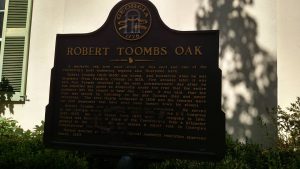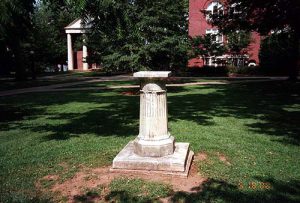Although the Robert Toombs Oak no longer stands on UGA’s north campus, there is a sundial to mark its place right outside of the Chapel and very close to Demosthenian Hall. There is a great deal of legend behind the oak tree, which was named in honor of Robert Toombs, the Secretary of State of the Confederacy. Toombs, who attended UGA from 1824-1828 and was an active member of the Demosthenian Literary Society, caused several problems due to his poor behavior during his time at university and was kicked out twice, the last time just a semester before graduating. Before his final dismissal, he had been chosen as the class speaker at his graduation ceremony. Toombs, determined to fulfill this duty and hoping to annoy university faculty and staff one last time, stood by the oak tree outside of the chapel during graduation and gave a loud speech, so boisterous that those in attendance left the ceremony and walked outside to listen to him speak. The oak became known as Robert Toombs Oak, and it is said that when the Confederate general died on December 15, 1885, lightning struck the tree. The oak tree was chopped down, and the Demosthenian Society took a part of the stump to keep in their hall. Today, the Demosthenians still incorporate the stump into their meetings by standing on it to make election speeches. Their sister society, the Dialectic and Philanthropic Society at the University of North Carolina, has another portion of the tree as well. The spot where the oak tree once stood is now denoted by a sundial, and a historical marker in honor of the Robert Toombs Oak was also placed beside Demosthenian Hall in March 1985.







